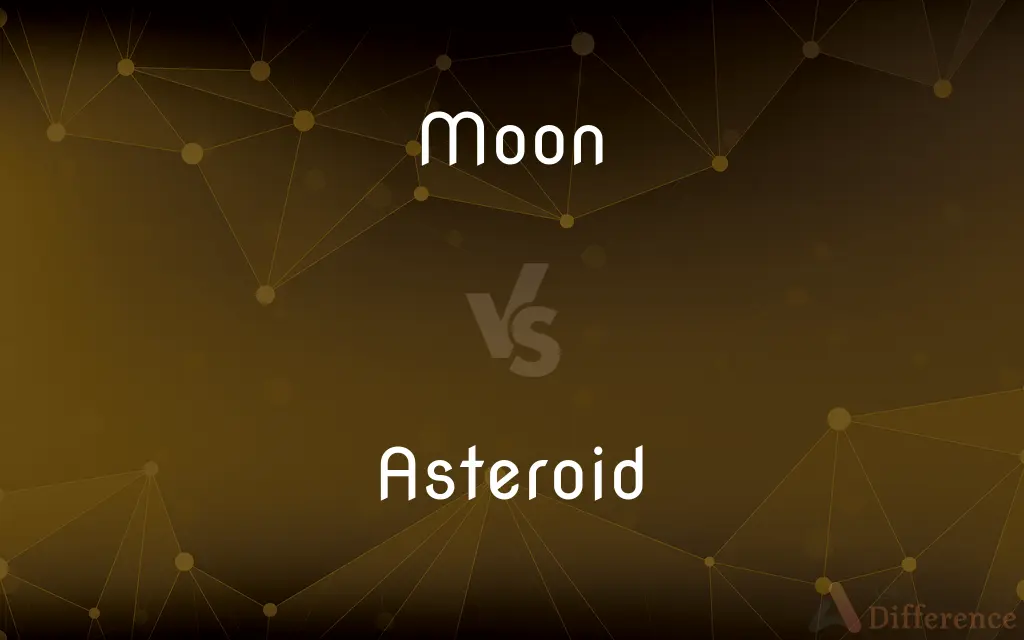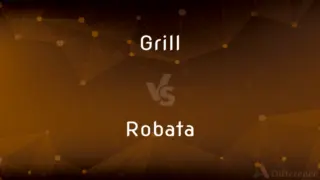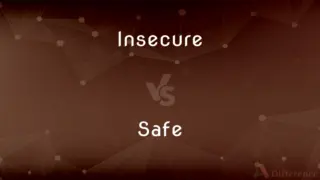Moon vs. Asteroid — What's the Difference?
Edited by Tayyaba Rehman — By Maham Liaqat — Updated on May 9, 2024
Moon is a natural satellite orbiting Earth with a stable trajectory and visible phases, whereas asteroids are smaller rocky bodies primarily found in the asteroid belt, with irregular orbits.

Difference Between Moon and Asteroid
Table of Contents
ADVERTISEMENT
Key Differences
The Moon, Earth's only natural satellite, exhibits a spherical shape due to its sufficient mass and gravitational pull. In contrast, asteroids generally have irregular shapes, often resembling lumpy rocks, because their smaller mass does not allow for gravitational rounding.
Orbiting approximately 384,400 kilometers from Earth, the Moon has a predictable path and influences Earth's tides through its gravitational pull. Asteroids, however, orbit mainly between Mars and Jupiter in the asteroid belt, with some having erratic orbits that cross Earth’s path, posing potential collision threats.
The Moon's surface is characterized by its plains called "maria," and highland areas, showing evidence of geological activity in the past. Meanwhile, asteroids often have a more varied composition, including metal, rock, and ice, which reflects their diverse origins and the conditions in their respective locations in the solar system.
One of the Moon's distinctive features is its impact on Earth's natural phenomena, such as eclipses and tidal variations. Asteroids do not influence Earth gravitationally to a significant extent, but their impacts have been crucial in shaping Earth's geological and biological history.
Scientifically, the Moon has been a focus of human exploration, resulting in manned lunar missions and numerous unmanned probes. On the other hand, asteroids are studied primarily through telescopes and space missions like NASA's OSIRIS-REx, aiming to understand more about the early solar system.
ADVERTISEMENT
Comparison Chart
Shape
Spherical due to gravitational pull
Irregular, often lumpy
Orbit
Stable, predictable, around Earth
Often irregular, primarily in the asteroid belt
Surface Features
Maria and highlands
Varied, can include metal and ice
Influence on Earth
Causes tides, eclipses
Minor gravitational influence, but impacts can alter geological/biological history
Focus of Exploration
Manned and unmanned missions
Mainly observed through telescopes and specific missions
Compare with Definitions
Moon
Earth’s natural satellite known for its phases.
The full moon brightens the night sky every month.
Asteroid
A small rocky body orbiting the sun.
The asteroid belt contains millions of asteroids.
Moon
A reference to something round and bright.
His face glowed like a moon in the dark room.
Asteroid
Used in studies to understand the solar system.
Asteroids help scientists study the conditions of the early solar system.
Moon
A celestial body that orbits a planet.
Jupiter has 79 moons, each orbiting the giant planet.
Asteroid
Composed mainly of rock and metal.
Most asteroids are remnants from the early solar system.
Moon
Used metaphorically to describe remoteness.
He lives out in the back of the moon where few people ever visit.
Asteroid
Known for their potential to collide with Earth.
Scientists monitor asteroids that could pose threats to Earth.
Moon
Symbolic of regular renewal.
Every new moon symbolizes a fresh start.
Asteroid
Occasionally enters Earth’s atmosphere.
When an asteroid enters the atmosphere, it often burns up as a meteor.
Moon
The Moon is Earth's only natural satellite. At about one-quarter the diameter of Earth (comparable to the width of Australia), it is the largest natural satellite in the Solar System relative to the size of its planet, the fifth largest satellite in the Solar System overall, and is larger than any known dwarf planet.
Asteroid
An asteroid is a minor planet of the inner Solar System. Historically, these terms have been applied to any astronomical object orbiting the Sun that did not resolve into a disc in a telescope and was not observed to have characteristics of an active comet such as a tail.
Moon
Often Moon The natural satellite of Earth, visible by reflection of sunlight and having a slightly elliptical orbit, approximately 363,100 kilometers (225,600 miles) distant at perigee and 405,700 kilometers (252,100 miles) at apogee. Its mean diameter is 3,475 kilometers (2,159 miles), its mass approximately one eightieth that of Earth, and its average period of revolution around Earth 29 days 12 hours 44 minutes calculated with respect to the sun.
Asteroid
(Astronomy) Any of numerous small solar system bodies that revolve around the sun, with orbits lying chiefly between Mars and Jupiter and characteristic diameters roughly between one and several hundred kilometers. Also called minor planet, planetoid.
Moon
A natural satellite revolving around a planet.
Asteroid
(Zoology) See starfish.
Moon
The moon as it appears at a particular time in its cycle of phases
A gibbous moon.
Asteroid
Star-shaped.
Moon
A month, especially a lunar month.
Asteroid
(zoology) Any member of the taxonomic class Asteroidea; a starfish
Moon
A disk, globe, or crescent resembling the natural satellite of Earth.
Asteroid
(astronomy) A naturally occurring solid object, which is smaller than a planet, larger than a meteoroid and not a comet, that orbits a star and often has an irregular shape.
Moon
Moonlight.
Asteroid
(astronomy) In the Solar system, such a body that orbits within the orbit of Jupiter
Moon
Something unreasonable or unattainable
They acted as if we were asking for the moon.
Asteroid
A starlike body; esp. one of the numerous small planets whose orbits lie between those of Mars and Jupiter; - called also planetoids and minor planets.
Moon
(Slang) The bared buttocks.
Asteroid
Any of numerous small celestial bodies composed of rock and metal that move around the sun (mainly between the orbits of Mars and Jupiter)
Moon
To wander about or pass time languidly and aimlessly.
Asteroid
Shaped like a star
Moon
To yearn or pine as if infatuated.
Moon
(Slang) To expose one's buttocks in public as a prank or disrespectful gesture.
Moon
(Slang) To expose one's buttocks to (others) as a prank or disrespectful gesture
"threatened to moon a passing ... camera crew" (Vanity Fair).
Moon
Senseid|en|Q405}} {{alternative case form of Moon.
Moon
Any natural satellite of a planet.
The stargazer observed the moons of Jupiter for over a year.
That's no moon, you idiot... it's a space station!
Moon
(literary) A month, particularly a lunar month.
They stayed with their aunt and uncle for many moons.
Moon
A representation of the moon, usually as a crescent or as a circle with a face; a crescent-shaped shape, symbol, or object.
The wizard costume was decorated with stars and moons.
Moon
A crescent-like outwork in a fortification.
The moons surrounding the city walls were built in the sixteenth century.
Moon
The eighteenth trump/major arcana card of the Tarot.
Moon
(cartomancy) The thirty-second Lenormand card.
Moon
(card games) In hearts, the action of taking all the point cards in one hand.
Moon
To display one's buttocks to, typically as a jest, insult, or protest.
The hooligans mooned the riot police.
It was ill-advised of Sam to moon the photographer during the shoot.
Moon
To gaze at lovingly or in adoration.
Moon
(usually followed by over or after) To fuss over something adoringly; to be infatuated with someone.
Sarah mooned over Sam's photograph for months.
You've been mooning after her forever; why not just ask her out?
Moon
To spend time idly, absent-mindedly.
Moon
(transitive) To expose to the rays of the Moon.
Moon
(transitive) To adorn with moons or crescents.
Moon
To rise in price rapidly or suddenly.
It is impractical if a currency moons and plummets often.
Moon
(card games) To shoot the moon.
Moon
The celestial orb which revolves round the earth; the satellite of the earth; a secondary planet, whose light, borrowed from the sun, is reflected to the earth, and serves to dispel the darkness of night. The diameter of the moon is 2,160 miles, its mean distance from the earth is 240,000 miles, and its mass is one eightieth that of the earth. See Lunar month, under Month.
The crescent moon, the diadem of night.
Moon
A secondary planet, or satellite, revolving about any member of the solar system; as, the moons of Jupiter or Saturn.
Moon
The time occupied by the moon in making one revolution in her orbit; a month.
Moon
A crescentlike outwork. See Half-moon.
Moon
The deliberately exposed naked buttocks.
Moon
To expose to the rays of the moon.
If they have it to be exceeding white indeed, they seethe it yet once more, after it hath been thus sunned and mooned.
Moon
To expose one's naked buttocks to (a person); - a vulgar sign of contempt or disrespect, sometimes done as a prank.
Moon
To act if moonstruck; to wander or gaze about in an abstracted manner.
Elsley was mooning down the river by himself.
Moon
The natural satellite of the Earth;
The average distance to the moon is 384,400 kilometers
Men first stepped on the moon in 1969
Moon
Any object resembling a moon;
He made a moon lamp that he used as a night light
The clock had a moon that showed various phases
Moon
The period between successive new moons (29.531 days)
Moon
The light of the moon;
Moonlight is the smuggler's enemy
The moon was bright enough to read by
Moon
United States religious leader (born in Korea) who founded the Unification Church in 1954; was found guilty of conspiracy to evade taxes (born in 1920)
Moon
Any natural satellite of a planet;
Jupiter has sixteen moons
Moon
Have dreamlike musings or fantasies while awake;
She looked out the window, daydreaming
Moon
Be idle in a listless or dreamy way
Moon
Expose one's buttocks to;
Moon the audience
Common Curiosities
Are there any asteroids that orbit planets like moons do?
Yes, some asteroids known as Trojan asteroids share orbits with planets, and a few have been found to orbit larger asteroids.
How do the orbits of the Moon and asteroids differ?
The Moon orbits Earth in a nearly circular path, while asteroids have a wide range of orbital shapes, many of which are highly elliptical.
What causes the phases of the Moon?
The phases of the Moon are caused by the changing positions of the Moon, Earth, and Sun, altering how much of the Moon's illuminated side is visible from Earth.
What is the largest asteroid, and how does it compare to the Moon?
The largest asteroid is Ceres, which is also classified as a dwarf planet, measuring about 940 km in diameter, significantly smaller than the Moon.
Do asteroids have atmospheres?
No, asteroids generally do not have atmospheres because they lack sufficient gravity to retain gaseous molecules.
What is the size comparison between the Moon and typical asteroids?
The Moon is significantly larger with a diameter of about 3,474 km, while most asteroids are much smaller, typically ranging from a few meters to several hundred kilometers in diameter.
How do scientists study asteroids?
Scientists study asteroids using telescopes, space missions, and sometimes by analyzing meteorites that have fallen to Earth.
How often do asteroids hit Earth compared to the Moon?
The Moon is constantly hit by meteoroids due to its lack of atmosphere. Earth experiences fewer impacts because its atmosphere burns up smaller meteoroids, but significant asteroid impacts, though rare, have occurred and can be catastrophic.
What missions have been sent to explore the Moon and asteroids?
The Moon has been explored by missions like Apollo (manned) and Lunar Reconnaissance Orbiter (unmanned). Asteroids have been studied by missions like OSIRIS-REx and Hayabusa2, which are unmanned.
What are the surface temperatures like on the Moon compared to asteroids?
The Moon experiences extreme temperatures ranging from about -173°C to 127°C. Asteroids, depending on their proximity to the Sun and their rotation, can also experience extreme temperature variations.
How does the gravitational influence of the Moon and asteroids compare?
The Moon has a significant gravitational influence on Earth, affecting tides and stabilizing Earth’s rotation. Asteroids have negligible gravitational impacts on Earth due to their smaller sizes.
What is the historical significance of the Moon compared to asteroids?
The Moon has had a profound influence on various cultures, calendars, and mythologies throughout human history. Asteroids have been studied scientifically in more recent times and are of interest due to their potential for Earth impacts and resources.
What role do the Moon and asteroids play in the future of space exploration?
The Moon is a target for future human colonization and as a staging point for deeper space exploration. Asteroids are of interest for mining resources and also for understanding the early solar system, which can inform future space missions.
Can asteroids have moons?
Yes, some larger asteroids have their own small moons, which are typically other smaller asteroids captured by their gravity.
What are the geological features of the Moon?
The Moon’s surface features include craters, maria (basaltic plains), highlands, and valleys, shaped by both internal processes and external impacts.
Share Your Discovery

Previous Comparison
Grill vs. Robata
Next Comparison
Insecure vs. SafeAuthor Spotlight
Written by
Maham LiaqatEdited by
Tayyaba RehmanTayyaba Rehman is a distinguished writer, currently serving as a primary contributor to askdifference.com. As a researcher in semantics and etymology, Tayyaba's passion for the complexity of languages and their distinctions has found a perfect home on the platform. Tayyaba delves into the intricacies of language, distinguishing between commonly confused words and phrases, thereby providing clarity for readers worldwide.
















































